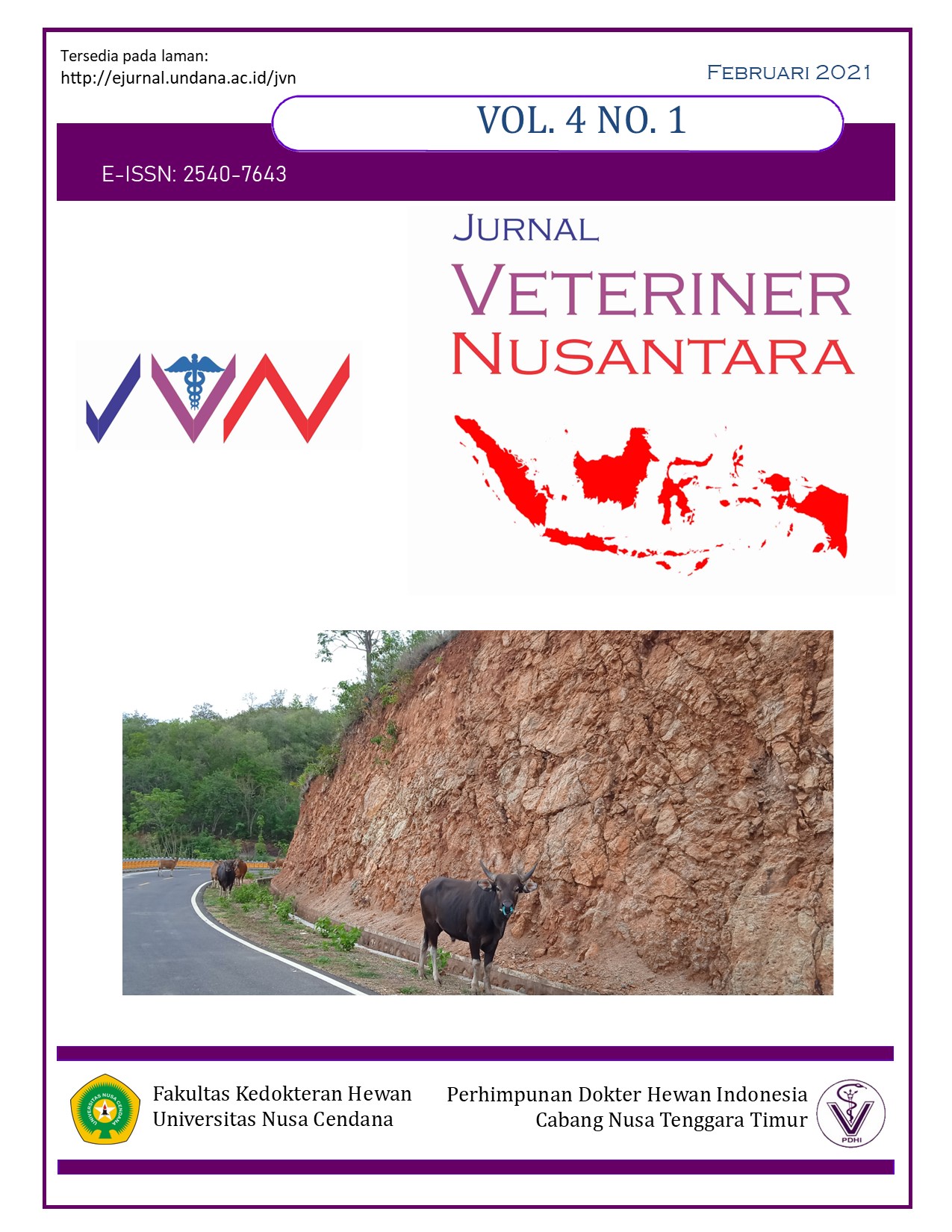Tingkat Pemahaman Dan Penerapan Higiene Dan Sanitasi Penjagal Dan Penjual Daging Babi Dan Ayam Di Kota Kupang
Abstract
This study aims to determine the level of understanding and application of hygiene and sanitation of pork and chicken sellers in 5 traditional markets in Kupang City as well as butchers of pork and chickens in Oeba slaughterhouse, Slaughterhouses, Poultry slaughterhouse in Naikoten and home industry in oeba. A total of 100 respondents of pork and chicken sellers and 60 slaughterers of pig and chicken were taken as research samples by questionnaire and interview method. The data collected were analyzed descriptively. The level of understanding of hygiene and sanitation of the pig-slaughterer is 80% good, 10% enough, 10% bad and the application is 60% good, 40% enough while for the understanding of the butchers, the value of 66.7% is good, 23.3% is enough and 10% is bad and the application is obtained value 33.3% good, 66.7% is enough. Among the pig and chicken slaughterers the best level of understanding and application is the butcher of pigs. Levels of understanding of pork sellers on hygiene and sanitation obtained 44% good, 54% enough. 2% bad and the application 32% good, 68% enough while for understanding chicken seller got 48% good, 52% enough with its application 76% good, 24% enough. Chicken meat seller have a better understanding and application of pork sellers. Good understanding affects one's application at work. The results obtained show the level of understanding and application of hygiene and sanitation of pork and chicken sellers and butchers of pigs and chickens in Kupang City.
Downloads
References
Aryana, S. 2011, Kondisi Sanitasi Peralatan dan Air terhadap Peningkatan Jumlah Total Mikroorganisme Susu Individu, Susu Kandang dan Susu Tempat Pengumpul Susu di Peternakan Kunak Bogor, Skripsi, SKH, Fakultas Kedokteran Hewan, Institut Pertanian Bogor, Bogor.
Badan Pusat Statistik. 2013, Potret Usaha Pertanian Kota Kupang menurut Subsektor, Badan Pusat Statistik Kota Kupang, Kupang.
Badan Standarisasi Nasional (BSN). 1999, SNI 01-6159-1999. SNI Rumah Potong Hewan (RPH), Jakarta.
Detha, A. 2014, Rumah Potong Hewan Untuk Kesehatan Masyarakat, LEMLIT UNDANA, Kupang.
Direktorat Kesehatan Masyarakat Veteriner dan Pasca Panen, 2010, Pedoman Produksi dan Penanganan Daging Ayam yang Higienis, Direktorat Jenderal Peternakan dan Kesehatan Hewan. Jakarta
Indriyani, KS, 2015, Analisis Hubungan Tingkat Kepuasan Kerja dan Efisisensi Kerja Tenaga Pengolah Makanan di RSPAD Gatot Soebroto Jakarta Skripsi, Bogor : Institut Pertanian Bogor.
Kusumawati, EL. 2005, Mempelajari Aspek Sanitasi [laporan paktik kerja lapangan], Bogor : Institut Pertanian Bogor.
Meggitt C. 2003. Food Hygiene and Safety. Oxford (US): Heinemann Educational Pub.
Notoatmodjo, 2003, Pendidikan dan Perilaku Kesehatan, Rineke Cipta : Jakarta.
, 2007, Promosi Kesehatan dan Ilmu Perilaku, Rineke Cipta : Jakarta.
Nubatonis, Y.D. 2015, Tingkat Cemaran Staphylococcus aureus Pada Daging Burger Dan Nugget Yang Dijual Di Kota Kupang, Skripsi, S.KH, Fakultas Kedokteran Hewan, Kupang.
Oyeneho and Hedberg. 2013. An Assessment of Food Safety Needs of Restaurants in Owerri, Imo State, Nigeria. International Journal of Environmental Research and Public Health, 10 (8): 3296-3309.
Padilla-Zakour. 2009. Good Manufacturing Practices. Dalam Heredia N, Wesley I, García S, editor, Microbiologically Safe Foods. New Jersey (US): John Wiley.
Rahayu ID. 2006. Tindakan-tindakan Pencegahan Penyakit. Malang (ID): Universitas Muhammadiyah Malang Pr.
Rohyati,E., Bernardus, N., dan Cardial, L.P.,2007, Kajian Kelayakan Operasional Rumah Pemotongan Hewan (RPH) Oeba Pemerintah Kota Kupang Nusa Tenggara Timur Dalam Menghasilkan Daging Dengan Kualitas Asuh, PARTNER, 17(02):162-171.
Sari, A.W. 2014, Tingkat Cemaran Mikroorganisme Pada Daging Sapi di Pasar Tradisional dan Pasar Modern di Kota Kupang, Skripsi, SKH, Fakultas Kedokteran Hewan, Kupang.
Schlundt, J., Toyofokudkk, H, Jansen, I., dan Herbst, S.A. 2004, Emerging food-borne Zoonoses. Rev Sci Tech, 23: 513-33
Soeparno. 2009, Ilmu dan Teknologi Daging, Cet.5, Universitas Gadjah Mada, Yogyakarta.
Suardana, I.W. dan Swacita, I.B.N. 2008, Buku Ajar Higiene Makanan, Edisi I, Cetakan I, Udayana Press. Denpasar
Sudrajat, A S, 2015, Analisis Biaya makanan terhadap ketersediaan makanan serta tingkat kecukupan gizi santri di Pondok Pesantren Darul Arqam Garut Skripsi, Bogor : Institut Pertanian Bogor.
Standar Nasional Indonesia. 1999. SNI-01-6160-1999. Rumah Pemotongan Unggas. Standarisasi Nasional-BSN : Jakarta.

 Anita Kartini Lakapu(1*)
Anita Kartini Lakapu(1*)



 Visit Our G Scholar Profile
Visit Our G Scholar Profile




